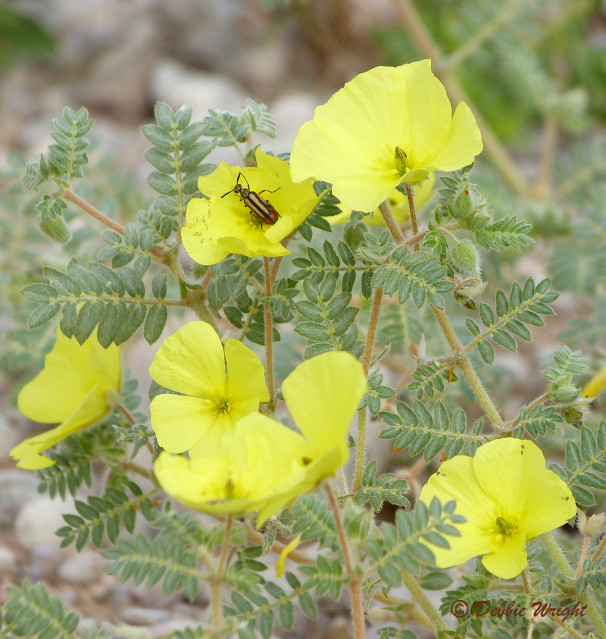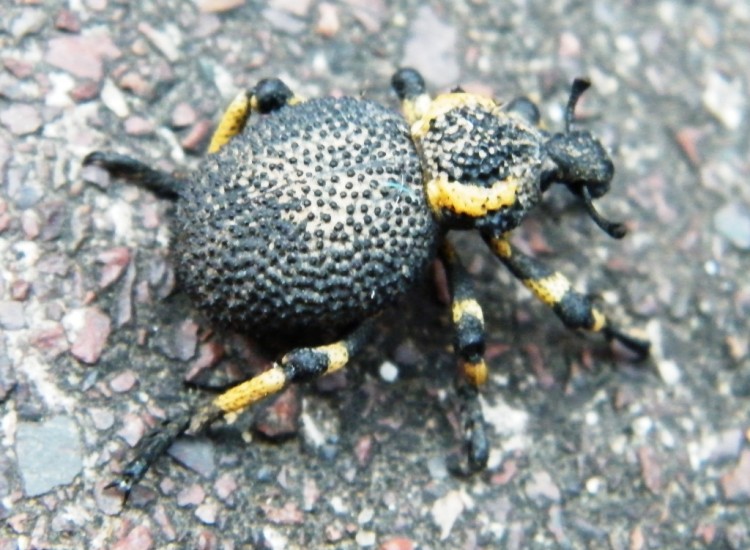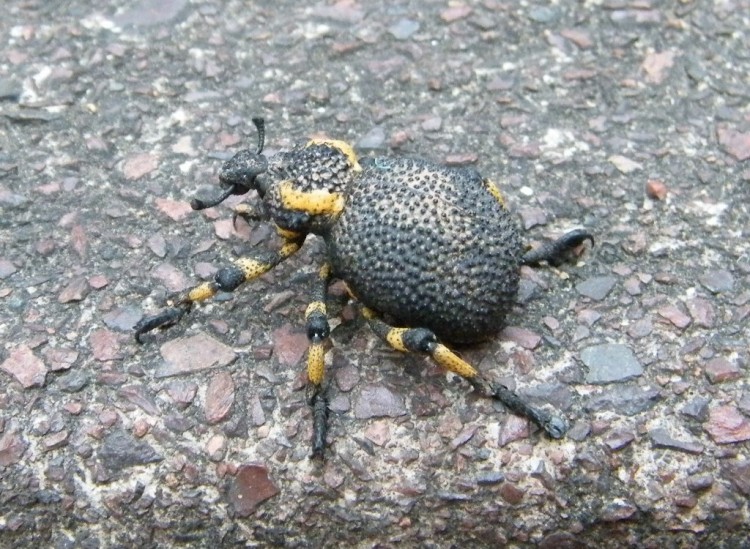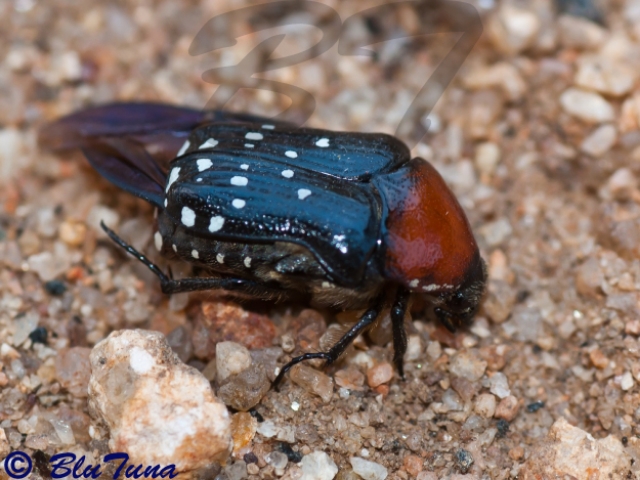Dung Beetle Scarabaeus (Drepanopodus) costatus
Suborder: Polyphaga. Family: Scarabaeidae. Subfamily: Scarabaeinae. Tribe: Scarabaeini.
Kgalagadi Transfrontier Park, Lijersdrai picnic spot © Michele Nel
Subgenus Drepanopodus
This subgenus is currently represented by 2 almost identical roller species of medium size, confined to Southern Africa:
S. D. costatus endemic to the arid regions (sw Kalahari) of South Africa, Namibia and Botswana.
S. D. proximus is confined to coastal Namaqualand, Namib desert
Description Scarabaeus (Drepanopodus) costatus
Length 15 mm. Habitus black with pronounced striae along the elytra.
Distribution and Habitat
This species is distributed in southern Africa across habitats associated with the hot, arid, deep sands centred on the southwest Kalahari, and areas neighbouring the Namib Desert
Biology
A telecoprid (ball-rolling) dung beetle. A generalist feeder, attracted to omnivore dung, dung of ruminants and dung pellets.
The majority of the species of Scarabaeini are adapted to open habitats and feed on resources that are usually patchy and ephemeral. True food specialisation is uncommon in the tribe. All scarabaeines have membranous filtering mouthparts that vary subtly in form and function, enabling the use of liquid components of various ruminant or non-ruminant animal dung types.
Links:
https://www.zin.ru/Animalia/Coleoptera/images/drepn.jpg
AW Insect Book: Beetles - Coleoptera
Moderator: Klipspringer
-
Klipspringer
- Global Moderator
- Posts: 5858
- Joined: Sat Sep 14, 2013 12:34 pm
- Country: Germany
- Contact:
-
Klipspringer
- Global Moderator
- Posts: 5858
- Joined: Sat Sep 14, 2013 12:34 pm
- Country: Germany
- Contact:
Re: AW Insect Book: Coleoptera. Carabidae
Peaceful Giant Ground Beetle Tefflus meyerlei delagorguei
Family Carabidae. Subfamily Anthiinae. Tribe Panagaeini.
 © Pumbaa
© Pumbaa
Kruger National Park, Satara
The genus Tefflus Latreille (Coleoptera: Carabidae) contains 14 species widely distributed throughout sub-Saharan Africa.
Members of this genus can be recognized by their large body size (24-55 mm in length), hexagonal pronotal shape, planate pronotal disc, elytral punctures in double rows separated by large elevated carinae, lack of functional flight wings, and lack of orange or yellow elytral markings. Males in this genus have the first and second tarsomeres of the protarsi enlarged.
In South Africa, these beetles are known by the popular name of 'peaceful giant ground beetles' to distinguish them from the 'oogpisters' of the tribe Anthiini, which spray highly concentrated acidic secretions from their pygidial glands when disturbed.
Description
Tefflus meyerlei delagorguei is the larger of the two species of Tefflus in South Africa (length 39-54 mm); vertex of head smooth with transverse rugae adjacent to eyes; pronotal punctures less distinct and often confluent; femora and tibiae with few if any stout suberect setae; elytral disc convex; elytral carinae as broad or broader than adjacent rows of punctures, top of each carina smooth and shining; integument
black and shining.
Distribution
Recorded from Free State, Gauteng, KwaZulu-Natal, Limpopo, and Mpumalanga Provinces. This species appears to be widely distributed in the Kruger National Park, from Punda Maria in the north to Pretoriuskop and Skukuza in the south.
Biology
Species of the genus Tefflus are predators of land snails, particularly the giant land snails in the genus Achatina. The activity patterns
of these snails are markedly associated with seasonal rains. Adult snails are active diurnally during rainfall events and remain active until the ground dries. After the ground dries, the adult snails are no longer active diurnally but may still be active nocturnally. The activity patterns of adults of T. m. delagorguei closely follow the activity patterns of their snail prey.
Adults of T. m. delagorguei are typically encountered singly, walking rapidly along the ground in open woodlands. The rapid walking behavior probably represents a foraging behavior aimed at detecting snail prey.
These beetles emit strongly scented pygidial gland secretions. As in other Carabidae, these secretions probably constitute an anti-predator defense.
Links:
http://publikationen.ub.uni-frankfurt.d ... ocId/21395
Family Carabidae. Subfamily Anthiinae. Tribe Panagaeini.
 © Pumbaa
© PumbaaKruger National Park, Satara
The genus Tefflus Latreille (Coleoptera: Carabidae) contains 14 species widely distributed throughout sub-Saharan Africa.
Members of this genus can be recognized by their large body size (24-55 mm in length), hexagonal pronotal shape, planate pronotal disc, elytral punctures in double rows separated by large elevated carinae, lack of functional flight wings, and lack of orange or yellow elytral markings. Males in this genus have the first and second tarsomeres of the protarsi enlarged.
In South Africa, these beetles are known by the popular name of 'peaceful giant ground beetles' to distinguish them from the 'oogpisters' of the tribe Anthiini, which spray highly concentrated acidic secretions from their pygidial glands when disturbed.
Description
Tefflus meyerlei delagorguei is the larger of the two species of Tefflus in South Africa (length 39-54 mm); vertex of head smooth with transverse rugae adjacent to eyes; pronotal punctures less distinct and often confluent; femora and tibiae with few if any stout suberect setae; elytral disc convex; elytral carinae as broad or broader than adjacent rows of punctures, top of each carina smooth and shining; integument
black and shining.
Distribution
Recorded from Free State, Gauteng, KwaZulu-Natal, Limpopo, and Mpumalanga Provinces. This species appears to be widely distributed in the Kruger National Park, from Punda Maria in the north to Pretoriuskop and Skukuza in the south.
Biology
Species of the genus Tefflus are predators of land snails, particularly the giant land snails in the genus Achatina. The activity patterns
of these snails are markedly associated with seasonal rains. Adult snails are active diurnally during rainfall events and remain active until the ground dries. After the ground dries, the adult snails are no longer active diurnally but may still be active nocturnally. The activity patterns of adults of T. m. delagorguei closely follow the activity patterns of their snail prey.
Adults of T. m. delagorguei are typically encountered singly, walking rapidly along the ground in open woodlands. The rapid walking behavior probably represents a foraging behavior aimed at detecting snail prey.
These beetles emit strongly scented pygidial gland secretions. As in other Carabidae, these secretions probably constitute an anti-predator defense.
Links:
http://publikationen.ub.uni-frankfurt.d ... ocId/21395
-
Klipspringer
- Global Moderator
- Posts: 5858
- Joined: Sat Sep 14, 2013 12:34 pm
- Country: Germany
- Contact:
Re: Africa Wild Insect Book: Beetles - Photos & Descriptions
Blister Beetle Ceroctis angolensis
Family Meloidae. Subfamily Meloinae. Tribe Mylabrini.
 © GavinW
© GavinW
Kgalagadi Transfrontier Park, Northern Cape
Description
This species is easily distinguishable by the elytral longitudinally vittate pattern.
Distribution
Angola, Botswana, Namibia and South Africa.
Links:
https://www.researchgate.net/profile/Ma ... -notes.pdf
Family Meloidae. Subfamily Meloinae. Tribe Mylabrini.
 © GavinW
© GavinWKgalagadi Transfrontier Park, Northern Cape
Description
This species is easily distinguishable by the elytral longitudinally vittate pattern.
Distribution
Angola, Botswana, Namibia and South Africa.
Links:
https://www.researchgate.net/profile/Ma ... -notes.pdf
-
Klipspringer
- Global Moderator
- Posts: 5858
- Joined: Sat Sep 14, 2013 12:34 pm
- Country: Germany
- Contact:
Re: Africa Wild Insect Book: Beetles - Photos & Descriptions
Lily Weevil Brachycerus labrusca
Family: Curculionidae. Subfamily: Brachycerinae, Tribe: Brachycerini

 © Richprins
© Richprins
Nelspruit, August 2020
A dark grey beetle, covered in warty tubercles.
The Brachyceridae (lily weevils) is a small weevil family, distributed in the Afrotropical region and in dry subtropical areas of the Palaearctic region. The genus Brachycerus Olivier, 1789, is the largest in the family, comprising about 500 species.
The biology of Brachycerus is closely associated with geophytes. Larval development takes place in the soil or inside the bulbs of plants of the Liliaceae, Amaryllidaceae, Araceae and Orchidaceae.
Links:
https://www.zobodat.at/pdf/Entomologisc ... 3-0559.pdf
Family: Curculionidae. Subfamily: Brachycerinae, Tribe: Brachycerini
Nelspruit, August 2020
A dark grey beetle, covered in warty tubercles.
The Brachyceridae (lily weevils) is a small weevil family, distributed in the Afrotropical region and in dry subtropical areas of the Palaearctic region. The genus Brachycerus Olivier, 1789, is the largest in the family, comprising about 500 species.
The biology of Brachycerus is closely associated with geophytes. Larval development takes place in the soil or inside the bulbs of plants of the Liliaceae, Amaryllidaceae, Araceae and Orchidaceae.
Links:
https://www.zobodat.at/pdf/Entomologisc ... 3-0559.pdf
-
Klipspringer
- Global Moderator
- Posts: 5858
- Joined: Sat Sep 14, 2013 12:34 pm
- Country: Germany
- Contact:
Re: Africa Wild Insect Book: Beetles - Photos & Descriptions
Common Dotted Fruit Chafer Cyrthothyrea (Cyrthothyrea) marginalis
Family Scarabaeidae. Subfamily Cetoniinae
Nelspruit © Richprins
Western Cape © Michele Nel
Cetoniinae beetles represent a very diverse group of Coleoptera. The majority of common species are diurnal, visit flowers for pollen and nectar or feed on fruits, and exhibit large ranges of occurrence.
Cyrthothyrea is an unrevised genus without modern treatment. Some species are reclassified as Oxythyrea in Beinhundner, G. (2017): The Cetoniinae of Africa: (Coleoptera : Scarabaeidae), but this taxonomic change is not widely accepted.
They are about 9 mm in size, black in colour with white dots or lines on the thorax, elytra and abdomen. Each species has its own distinctive pattern. Cyrtothyrea are active during the day, and are often found on flowers, while feeding on nectar. They are pollinators of several plant groups.
Identification Cyrthothyrea marginalis
Size: 9 mm. Clypeus, antennae and pygidium black, remainder of integument black with a lot of white spots; with lateral margins of pronotum reddish brown. Pronotum lightely punctured.
A very common species found at numerous locations almost all over South Africa. A typical flower feeder that has been observed on a large variety of plants, often in quant.
Family Scarabaeidae. Subfamily Cetoniinae
Nelspruit © Richprins
Western Cape © Michele Nel
Cetoniinae beetles represent a very diverse group of Coleoptera. The majority of common species are diurnal, visit flowers for pollen and nectar or feed on fruits, and exhibit large ranges of occurrence.
Cyrthothyrea is an unrevised genus without modern treatment. Some species are reclassified as Oxythyrea in Beinhundner, G. (2017): The Cetoniinae of Africa: (Coleoptera : Scarabaeidae), but this taxonomic change is not widely accepted.
They are about 9 mm in size, black in colour with white dots or lines on the thorax, elytra and abdomen. Each species has its own distinctive pattern. Cyrtothyrea are active during the day, and are often found on flowers, while feeding on nectar. They are pollinators of several plant groups.
Identification Cyrthothyrea marginalis
Size: 9 mm. Clypeus, antennae and pygidium black, remainder of integument black with a lot of white spots; with lateral margins of pronotum reddish brown. Pronotum lightely punctured.
A very common species found at numerous locations almost all over South Africa. A typical flower feeder that has been observed on a large variety of plants, often in quant.
-
Klipspringer
- Global Moderator
- Posts: 5858
- Joined: Sat Sep 14, 2013 12:34 pm
- Country: Germany
- Contact:
Re: Africa Wild Insect Book: Beetles - Photos & Descriptions
Cape Green Protea Chafer Trichostetha fascicularis fascicularis
Family Scarabaeidae. Subfamily Cetoniinae. Tribe Diplognathini
Kirstenbosch, Western Cape. Feeding on King Protea © Michele Nel
Identification
Size: 25mm. It has metallic-green elytra with distinctive grooves and punctures that run horizontally down the wingcases. Head black. Prothorax black with four thin white longitudinal lines. The underside bears distinct yellow/orange hairs; these hairs catch pollen as the beetle feeds. Tufts of orange hair are visible from above.
Adults fly noisily around Protea bushes and when they visit the flowers, they bury themselves head first. During feeding, they use dense brushes of setae on the tips of their maxillae to mop up nectar and sweep pollen into their mouths.
These beetles are not attracted to fruit as is the case in many other cetoniids.
The Green Protea Beetle is found on most Sugarbushes, but prefers the Bearded and Spoon-bract Sugarbushes. These beetles are large and powerful enough to force their way into the flowerheads and thus pollinate the flowers.
Family Scarabaeidae. Subfamily Cetoniinae. Tribe Diplognathini
Kirstenbosch, Western Cape. Feeding on King Protea © Michele Nel
Identification
Size: 25mm. It has metallic-green elytra with distinctive grooves and punctures that run horizontally down the wingcases. Head black. Prothorax black with four thin white longitudinal lines. The underside bears distinct yellow/orange hairs; these hairs catch pollen as the beetle feeds. Tufts of orange hair are visible from above.
Adults fly noisily around Protea bushes and when they visit the flowers, they bury themselves head first. During feeding, they use dense brushes of setae on the tips of their maxillae to mop up nectar and sweep pollen into their mouths.
These beetles are not attracted to fruit as is the case in many other cetoniids.
The Green Protea Beetle is found on most Sugarbushes, but prefers the Bearded and Spoon-bract Sugarbushes. These beetles are large and powerful enough to force their way into the flowerheads and thus pollinate the flowers.
-
Klipspringer
- Global Moderator
- Posts: 5858
- Joined: Sat Sep 14, 2013 12:34 pm
- Country: Germany
- Contact:
Re: Africa Wild Insect Book: Beetles - Photos & Descriptions
Dung Beetle Copris sp. Possibly Copris amyntor
Family Scarabaeidae. Subfamily Scarabaeinae. Tribe Coprini
Female, Marloth © Richprins
Copris is a genus of dung beetles in the tribe Coprini (subfamily Scarabaeinae) of the scarab family. It comprises more than 250 species and has an almost worldwide distribution. They are large, nocturnal fast burying tunnelers. They are only active (and present in superficial dung) immediately after rainfall, and then either return to a temporal state of dormancy or remain in brood chambers deep underground.
Female Copris are difficult to identify.
Family Scarabaeidae. Subfamily Scarabaeinae. Tribe Coprini
Female, Marloth © Richprins
Copris is a genus of dung beetles in the tribe Coprini (subfamily Scarabaeinae) of the scarab family. It comprises more than 250 species and has an almost worldwide distribution. They are large, nocturnal fast burying tunnelers. They are only active (and present in superficial dung) immediately after rainfall, and then either return to a temporal state of dormancy or remain in brood chambers deep underground.
Female Copris are difficult to identify.
-
Klipspringer
- Global Moderator
- Posts: 5858
- Joined: Sat Sep 14, 2013 12:34 pm
- Country: Germany
- Contact:
Re: Africa Wild Insect Book: Beetles - Photos & Descriptions
Giant Emerald Fruit Chafer Dicronorhina derbyana derbyana
Family Scarabaeidae. Subfamily Cetoniinae. Tribe Goliathini
Female. Garden in Gauteng © Alf
Dicronorhina is a genus of large horned goliath beetles from tropical Africa. The head of the males is strongly modified: clypeus of male with Y- or T-shaped anteromedian projection (horn).
Identification
Size: 30-60 mm. Elytra emerald with variable pattern. Specimens may be more or less striped with larger or smaller green areas and may have an ochre sheen on the pronotum or elytra. The male bears a forward-projecting T-shaped flat horn.
Distribution
Botswana, Malawi, Mozambique, Namibia, South Africa, Zimbabwe, Zambia.
Links:
https://repository.naturalis.nl/pub/317 ... 233001.pdf
Family Scarabaeidae. Subfamily Cetoniinae. Tribe Goliathini
Female. Garden in Gauteng © Alf
Dicronorhina is a genus of large horned goliath beetles from tropical Africa. The head of the males is strongly modified: clypeus of male with Y- or T-shaped anteromedian projection (horn).
Identification
Size: 30-60 mm. Elytra emerald with variable pattern. Specimens may be more or less striped with larger or smaller green areas and may have an ochre sheen on the pronotum or elytra. The male bears a forward-projecting T-shaped flat horn.
Distribution
Botswana, Malawi, Mozambique, Namibia, South Africa, Zimbabwe, Zambia.
Links:
https://repository.naturalis.nl/pub/317 ... 233001.pdf
-
Klipspringer
- Global Moderator
- Posts: 5858
- Joined: Sat Sep 14, 2013 12:34 pm
- Country: Germany
- Contact:
Re: AW Insect Book: Beetles - Photos & Descriptions
Variable Fruit Chafer Clinteroides permutans
Superfamily Scarabaeoidea. Family Scarabaeidae. Subfamily Cetoniinae. Tribe Cetoniini
 © BluTuna
© BluTuna
Kruger National Park, Nhlanguleni
Description
Fairly small and shiny, variable with orange and black colour patterns. Dark reddish brown to black with white spots. Pronotum is often red.
Distribution
Mozambique, Zimbabwe, South Africa, Botswana, eSwatini.
Links:
https://www.gbif.org/species/1076708
Superfamily Scarabaeoidea. Family Scarabaeidae. Subfamily Cetoniinae. Tribe Cetoniini
 © BluTuna
© BluTunaKruger National Park, Nhlanguleni
Description
Fairly small and shiny, variable with orange and black colour patterns. Dark reddish brown to black with white spots. Pronotum is often red.
Distribution
Mozambique, Zimbabwe, South Africa, Botswana, eSwatini.
Links:
https://www.gbif.org/species/1076708
-
Klipspringer
- Global Moderator
- Posts: 5858
- Joined: Sat Sep 14, 2013 12:34 pm
- Country: Germany
- Contact:
Re: Africa Wild Insect Book: Beetles - Photos & Descriptions
Longhorn Xystrocera erosa
Family Cerambycidae. Subfamily Cerambycinae. Tribe Xystrocerini

Xystrocera erosa var. viridis female with greenish sheen on the elytra. Nelspruit (Dec 2020) © Richprins
Xystrocera species have a more or less angulated apex of the scape, which can sometimes form a distinct spine. The eyes are coarsely facetted typical for nocturnal species. They have a very short head, vertical forehead, flattened elytra, adsperate antennae, swollen femurs and flattened tibiae.
Description
Size: 10 to 40 mm.
Dull metallic green.
Head much narrower than the prothorax, brown, closely punctured; antennae brown, the proximal joints roughly punctured, unarmed.
Prothorax finely punctured, depressed, as broad as the elytra, and about equal in length and width, the sides rounded.
Scutellum chestnut-brown, rounded behind, very concave in the middle.
Elytra with numerous small brownish granulations, each elytron with three longitudinal raised lines and a rounded apex.
Body beneath, except the propectus, glossy brown, legs darker.
Geographical distribution
Mozambique, Zimbabwe, Botswana, South Africa, Lesotho.
Links:
https://www.cerambycoidea.com/titles/pascoe1864c.pdf
http://www.cerambycoidea.com/forum/topi ... C_ID=15110
Family Cerambycidae. Subfamily Cerambycinae. Tribe Xystrocerini
Xystrocera erosa var. viridis female with greenish sheen on the elytra. Nelspruit (Dec 2020) © Richprins
Xystrocera species have a more or less angulated apex of the scape, which can sometimes form a distinct spine. The eyes are coarsely facetted typical for nocturnal species. They have a very short head, vertical forehead, flattened elytra, adsperate antennae, swollen femurs and flattened tibiae.
Description
Size: 10 to 40 mm.
Dull metallic green.
Head much narrower than the prothorax, brown, closely punctured; antennae brown, the proximal joints roughly punctured, unarmed.
Prothorax finely punctured, depressed, as broad as the elytra, and about equal in length and width, the sides rounded.
Scutellum chestnut-brown, rounded behind, very concave in the middle.
Elytra with numerous small brownish granulations, each elytron with three longitudinal raised lines and a rounded apex.
Body beneath, except the propectus, glossy brown, legs darker.
Geographical distribution
Mozambique, Zimbabwe, Botswana, South Africa, Lesotho.
Links:
https://www.cerambycoidea.com/titles/pascoe1864c.pdf
http://www.cerambycoidea.com/forum/topi ... C_ID=15110


